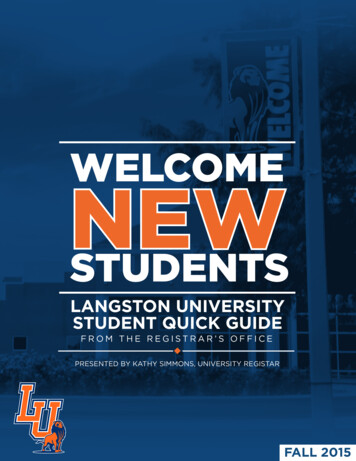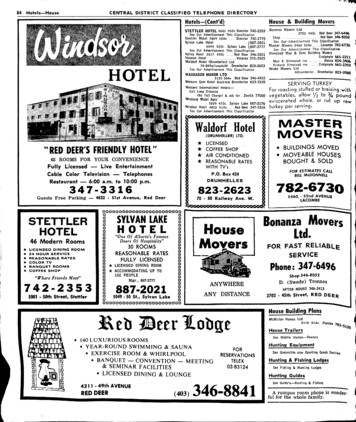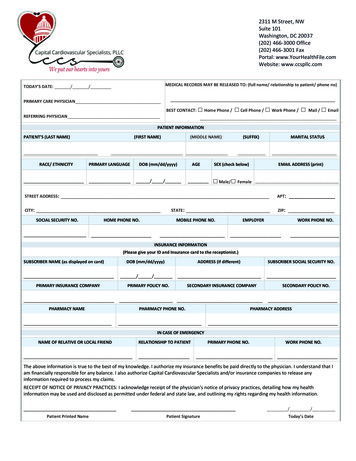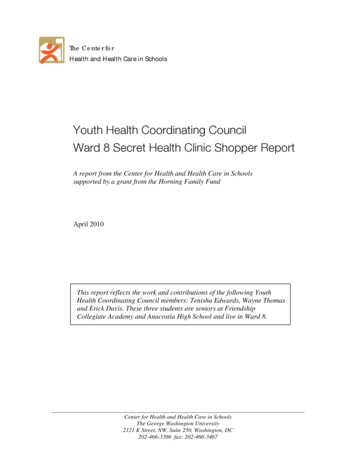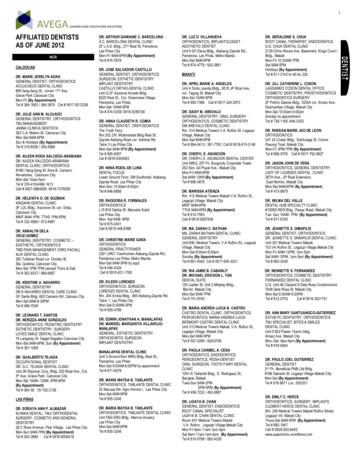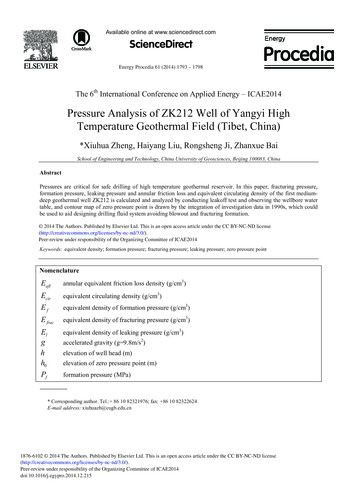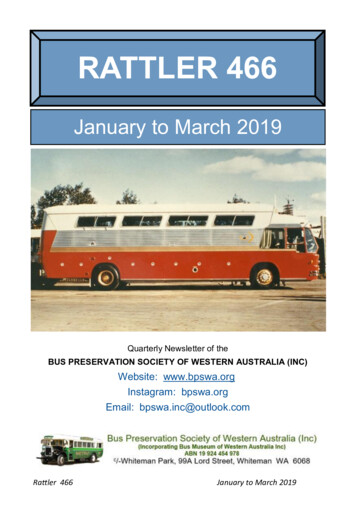
Transcription
RATTLER 466January to March 2019Quarterly Newsletter of theBUS PRESERVATION SOCIETY OF WESTERN AUSTRALIA (INC)Website: www.bpswa.orgInstagram: bpswa.orgEmail: bpswa.inc@outlook.comRattler 466January to March 2019
Cover photograph: WAGR Railway Road Service Guy Victory WUM G58 "Pride of theWest" with a Motor Body Builders body in service, 1960s.Photo: BPSWA Archives; N Pusenjak collection.ContentsIndexFrom The BPSWA Council . 3Bus 466 for Rattler 466 . 4WA Bus Body Manufacturers SBS & MBB pt2. . 8Bussing Aruba Style . 15Restoration—Malcolm Nixon’s Daimler . 16Catching the Bus . 21Buses of Yesteryear . 22Workshop News . 26Recent Events. 33Coming Events. 34Bus Museum Work Days . 35Rattler 465 Updates and Corrections:P15—The picture of MTT 465 was taken on 30th November 1986 when the Roman CatholicPope conducted a mass at the Belmont Racecourse.P16—MTT 988 was incorrectly described as a Leyland Leopard—it is of course a LeylandPanther and is part of the BPSWA collection. 2019 BUS PRESERVATION SOCIETY OF WESTERN AUSTRALIA (Inc)RATTLER is published for BPSWA members as part of their membership subscription. Materialpublished in RATTLER may not be reproduced in any form whatsoever unless prior writtenapproval is obtained from the Editor, except in the case of information extracted from newsitems which may be used in kindred enthusiast publications provided that due acknowledgementof the source is made. The opinions expressed in articles in RATTLER are those of therespective authors and do not necessarily reflect or coincide with the views of the BusPreservation Society of Western Australia (Inc) or of RATTLER’s Editor.Please address correspondence to:The President: Tom Curtis, or, The Secretary: Andrew KerrBPSWA (Inc) C/- Whiteman Park99A Lord StreetWHITEMAN WA 6068Or, contact us via:Our Website: www.bpswa.org then click on the Contact Us page.Our Email: bpswa.inc@outlook.comRattler 4662January to March 2019
FROM THE BPSWA COUNCILSpecial General Meeting:A Special General Meeting has been arranged for Saturday 20th April at theworkshop and all members are urged to attend. The current BPSWAconstitution is due for replacement this year and the new version must beaccepted by a quorum of the general membership. A sausage sizzle willcommence at 12 noon followed by a discussion of the new constitution.Input from all members is encouraged.Museum Plans: The Council has identified the need for a museumbuilding for displaying our buses as our highest priority in the next fewyears. We have a sizeable collection of fully restored and in many casesoperational buses that we are now ready to share with the broadercommunity. Our members may not be fully aware that we have one of thelargest collections of such buses in the Southern Hemisphere and ourcollection has been assessed as being of National Significance by theNational Library in Canberra. We have a working group looking at thequestion of how we can achieve our aim of building such a museum. Thegroup has already held a preliminary meeting with Whiteman Parkmanagement and we have identified a parcel of land that is available to usfor this purpose. Further meetings with the Motor Museum and then withLotterywest are to be held to discuss funding, architectural and planningprocedures and other requirements that we need to meet to get ourmuseum building up and underway. Again we are looking for all ourmembers input to see this project successfully undertaken and if you haveany thoughts, suggestions or ideas that will impact on a museum displayarea, please let any member of the council know or else send an email toour website address. There will be special meetings called shortly andduring the life of the project so that everyone has a chance to have inputand be kept up to date on what is happening with this project.We are now on Instagram!: New member, Shaked Munn, has beenproviding us with advice on how to establish an effective Instagramaccount. Our thanks to Steven Pitcher who has taken on the task ofpopulating our account with stories of our buses and community eventsparticipation. Spread the news and follow us on Instagram at bpswa.orgRattler 4663January to March 2019
BUS 466 FOR RATTLER 466The first bus numbered 466 in the MTT fleet was a rare, rear engine Fodenmodel FVRG6 acquired from the North Beach Bus Company in October 1961following the takeover of that fleet. The bus was placed in service by theNBBC in September 1954.The 49 seat bus was powered by the reliable, slow revving and economicGardner 6LW diesel engine favoured by many operators. The engine waseither the 102hp version or the later, uprated 112hp model. A constant mesh(crash) gearbox was fitted with long linkages from the front to the reartransmission. Bolton’s angular body gave the bus an austerity appearance,added to by its economy sliding windows in the passenger saloon.Unusually, the destination blind was positioned below the windscreen. Thismay have been moved when a route number box was added by the MTT.NBBC’s main route was from a city terminus in Murray St via Wellington St toSutherland and Charles Streets, then North Beach and Balcatta Roads toNorth Beach. An extension ran along The Esplanade to Waterman Bay.North Beach number 16 photographed in 1954 at the North Beach depot in Wanneroo Rd, TuartHill.Photo: BPSWA Archives, Nick Pusenjak collection.Rattler 4664January to March 2019
Another important route ran along Scarborough Beach Rd and Main St toOsborne Park. This was formerly part of early tram route number 16.The W.A. rear engine Fodens (only 3 in total) were said to have experiencedproblems with the right-angle transmission drive from the transverse engineto the gearbox and differential, and some drivers found the crash gear boxesdifficult to handle in stop/start suburban work, probably accentuated by thelong gear linkages along the chassis when worn.When the bus was taken over by the MTT in 1961, the model had been out ofproduction for ten years. Spare parts were increasingly hard to obtain andthis resulted in a decision to withdraw the vehicle prematurely in July 1964after a life of just ten years. Only the Gardner engine and some fittings wereremoved by the MTT. The remainder was sold as a rolling shell to Bell Bros.for use in their mobile accommodation fleets that moved from one outbackproject to another.For readers interested in the rear engine Fodens that came to W.A., Rattler436 has a descriptive article on pages 33-37 compiled by Nicholas Pusenjakwith the assistance of Peter Tulloch. It is available on the BPSWA website.A second MTT number 466 started life in March 1953 as Metro 62, a 48 seatLeyland Royal Tiger OPSU1-1 with a timber frame body built by CampbellAn historic photo of Metro 62 (rebadged as MTT 62) pictured mid-morning in St George’s Tce,adjacent to Stirling Gardens in late 1958 or early 1959. The bus is departing for Fremantle viaApplecross. In the queue behind are a Beam OB - one of the few operated briefly by the MTTafter taking over Beam Transport Ltd, a Dennis Lancet IV J7, and in the background anotherLeyland Royal Tiger destined for Fremantle via Canning Bridge. There is a fine selection of1950s cars and delivery trucks in view, together with a typical crosswalk and dress fashions ofthe period. Photo: BPSWA Archives.Rattler 4665January to March 2019
and Mannix. The bus carried the same number in the MTT and wasconverted by them in 1966 to a 49 seat bus by removing the rear door andreplacing it with an emergency window.During a major refurbishment halfway through its useful life, enlarged frontwindscreens were fitted and the half drop saloon windows were replaced byaluminium versions at Kensington St, substantially altering the appearanceof the bus. Towards the end, in June 1974, it was renumbered 466 to makeway for new fleet acquisitions.Bus number 466 was the last Leyland Royal Tiger to be operated by theMTT and was retired in August 1978 after a creditable 25 year’s rigorousservice. It was sold to a Mr D Rees of Bunbury.A third MTT number 466 was a Leyland Tiger Cub PSUC1-13 brieflynumbered 464 between its first number 738 and its final number 764. Thebus was similar to the Tiger Cub featured on page 6 in Rattler 464 and waspart of the MTT fleet from 1967 to November 1980 when it was sold to thePenrith District Bus Service in Sydney.A fourth MTT number 466 was Mercedes Benz M407 913 6 Cyl. 11.413L 20hp diesel with an auto 3 speed gearbox. The bus went on the road inSeptember 1984 and was withdrawn and stored in May 2008 prior toMetro 62/MTT 62/MTT 466 in its refurbished form photographed in Goldsborough St betweenCantonment St and Elder Place, Fremantle, during a BPSWA ‘Extravaganza’ in March 1978 inthe months leading up to its withdrawal. Photo: Colin Davison.Rattler 4666January to March 2019
disposal in March 2009.BPSWA member Colin Davison advises that number 466 wore the finalversion of the MTT 'arrow' livery applied to Perth's Mercedes Benz O305buses - featuring reflective white fleet numbers and a 'plain' MTT logo ofgreen letters on white background, plus black anodised aluminium windows.It was an attempt to 'upgrade the image' of the MTT by then Chairman LeslieHyland. One day after Jim Bond photographed 466 in Wellington Street on30 August 1986, Mr Hyland's successor, Stuart Hicks, announced theadoption of ‘Transperth’ as the new trading name for the Metropolitan(Perth) Passenger Transport Trust, drawing a figurative line between 'the old'MTT brand and 'the modern' Transperth one.The location is Wellington Street, Perth, August 1986. Mercedes 466 is operating an outboundtrip via MTT route 84 to City Beach. These days, Transperth route 84 travels along part of theMTT route, but to Wembley Downs. A subtle reminder that it is not only the buses whichchange over the years, so do the routes they follow and the people they serve.Just visible above the roof of 466 is a sign uniquely related to the once ubiquitous (in PerthCBD) blue and yellow City Clipper buses. MTT route 84 buses heading out of Perth only hadone stop with such a 'flag' - opposite the erstwhile Perth Entertainment Centre and a little to theEast of Milligan Street. This really narrows down the location and a slice of past history’Photo: Jim Bond courtesy of David Urquhart collection.Sources:Rattler N. Pusenjak and P. Tulloch, Rattler 436, April – June 2011, pp33-37.Colin Davison noteswww.perthbus.infoRattler 4667January to March 2019
WA BUS BODY MANUFACTURERSWA Bus Body ManufacturersPart 3.2 – Scarborough Bus Service and Motor Body BuildersBy Malcolm CrosbieAssistance from BPSWA member Ray Nankivell is acknowledged in thepreparation of this article. Details of Ray’s experience are given in thereference to this article.Part 3.1 of this article focussed on the Scarborough Bus Service and MotorBody Builders up to and including the Daimler half-cabs and full frontalrebuilds. Part 3.1 appeared in the previous RATTLER. This part considersthe Daimler underfloor buses and other buses produced by MBB.Daimler Under-floorsWith Kalamunda and Metro leading the way with underfloor engined buses,Scarborough was not going to be left behind and ordered underfloor enginedbuses to be built by the newly formed Motor Body Builders at the rear of theirSBS workshop. All eleven underfloor buses ordered by SBS had theirbodies built by MBB, although after being taken over by MTT (except for SBS38 which was withdrawn from MTT service in 1968) they were rebodied in1968, in a style more consistent with standard MTT designs.Scarborough Bus Service 10 "Albatross", Daimler Freeline D650 HS with MBB body, at depotc1954. Later MTT 457. Photo: BPSWA ArchivesRattler 4668January to March 2019
SBS Underfloor-engined DaimlersSBSNoMTTNoIn serviceBird s457Bolton7/681/78Busselton t458-1/63 chassiscrackedParts321/55Rifle Bird459H Porter7/681/78M Brockwell,Horizon West331/55Bosun460H Porter6/6810/68Engine to 293Parts (body ex458 by MBB)345/55Petrel461H Porter6/688/78Geraldton StPatricks 64Bolton6/689/78Barrett4212/57-465H Porter7/688/78Shoeman-RebuiltWithdrawnDisposalNB 1: SBS 15 was the last SBS bus in MTT service.NB 2: SBS bodies were 48 seats, single door with a rear emergency door.Rebuilt bodies were 45 seats, 2 doors (second door after the rearaxle) and an emergency rear window.NB 3: SBS38 was rebuilt by MBB in 9/66 as a 49 seater.NB 4: SBS 41 was the last bus SBS put into service prior the company’sforced takeover by MTT.Scarborough Bus Service Semi-TrailersScarborough’s semi-trailers have been mentioned in some detail in Rattler464. In summary, all six trailers had their bodies built by MBB, (althoughBoltons assisted with the initial wooden mock-up to get the design licensed),all four White WA 20 prime movers had their bodies built by SBS or MBB,and four Foden prime movers had their bodies built by MBB, while the fifthFoden prime mover had its body built by Boltons.Austin Series 2 in SBS ServiceThe need to meet the growing population in the Woodlands, Innaloo,Doubleview and Scarborough area, together with some difficulties in gettingDaimler chassis from the U.K quickly enough, led Mr Harold Millett to useAustin/BMC (British Motor Corporation) chassis with a lengthened chassis(to increase seating capacity). Ray Nankivell obtained an engineeringRattler 4669January to March 2019
approval from BMC for this chassis lengthening to produce 39 seater buses.Although these buses were smaller and lighter than the Daimler underfloorbuses, they were noticeably cheaper and would last the four years before thethreatened MTT takeover of the company and its routes,SBS NoIn serviceMTT NoMTT withdrawnLater use3512/55529/63Parts362/56539/63Baptist church3910/56543/63Bullsbrook4012/56553/63?MBB Builds for OthersMBB built the body for Riverton Bus Service on a Daimler D650HS chassis.This bus entered service in February 1954 as a 48 seater, was renumberedas 455 in MTT service in May 1961, rebuilt to a 49 seater in March 1966 andwas withdraw from MTT service in February 1972, being converted to parts,with the body-on-wheels passing to the WA Transport Museum in 1974.The Railway Road Service had seven Guy Victory buses, three of whichwere raised passenger deck “Scenicruisers” (named “Pride of the West”,“Queen of the South” and “Wheatlander”, which were 36 seaters) and theother four were single deck (G63 was a 34 seater, the others were 36Scarborough Bus Service 32 "Rifle Bird", Daimler D650HS in MTT 459 livery still with its MBBbody prior to 1968. Photo: BPSWA Archives; N Pusenjak collection.Rattler 46610January to March 2019
seaters). As John Young mentioned(6, p205) these buses were “30 yearsahead of their time with hydraulic disc brakes, air suspension andindependent front suspension. They had a lot of mechanical problems . .”,which probably explains their service life of only about 11 years for the threenamed buses. G64 did not get its body until after the other buses, as it washeld for spares, until its body was built by Martin Nixon in 1964. (MBBhaving closed in the early 1960s.)Above: Scarborough Bus Service 36, Austin Series 2, photographed in Mt Hawthorn, c1958.Photo: BPSWA Archives; Ian Atkins collection.Below: Riverton Bus Service 4 Daimler Freeline D650HS with MBB body. Later MTT 455.Photographed outside the SBS/MBB premises when new in February 1954.Photo: BPSWA Archives; Nick Pusenjak collection.Rattler 46611January to March 2019
Railway Road Service Guy Victory BusesWAGRRRS NoNameBody byIn ServiceWithdrawnG58Pride of the WestMBB7/61Before 1972G59Queen of the SouthMBB7/61Before 1972G60WheatlanderMBB9/61Before Martin Nixon9/64?MBB Rebuilds for the Railway Road Servivce(4)The Western Australian Government Railway Road Service had seventeenAEC Mk III half cab buses, originally bodied by Boltons with wooden framedbodies in 1947 to 1949,. From the late -1950s most of these buses wererebodied by “Comeng” (Commonwealth Engineering), Boltons, or HowardPorter, although 7 were rebodied by MBB (A17 in August 1956; A25 inSeptember 1959; A5 in November 1959; A12 in July 1960; A7 in April 1960;A10 in August 1960; and A16 in October 1961), with the re-bodying involvingconversion to full-fronted metal framed body and in most cases, slopingpassenger windows. In the early post WW2 years, country WA roads wereoften gravel or crushed limestone with corrugations and/or potholes and thewooden framed bus bodies suffered from the extensive use on such roads.Three of these 17 AEC Mk III buses were also later converted to tow twoaxled luggage trailers.The RRS also inherited three full fronted AEC Mk IIIs from the MidlandRailways (when the WAGR took over the MR in 1948). These three buseswere also rebodied by MBB (ex MR 5 which became RRS A70 was re-bodiedin June 1960; ex MR 6, which became RRS A71 was re-bodied in November1961; and ex MR 8 which became RRS 72 was re-bodied in 1962).Various Owners – Austin ChassisRay Nankivell mentioned that when Daimler chassis became difficult toobtain from the UK, MBB went looking for business in the school bus marketand obtained many orders. Orders also came for furniture removal vans andtrucks as well as from country bus companies, and from funeral directors forhearses.Rattler 46612January to March 2019
WAGR Railway Road Service Guy Victory WUM G58 "Pride of the West" and G59 "Queen ofthe South" stored at the Kensington St East Perth WAGR RRS Workshop, c1971.Photo: BPSWA Archives; N Pusenjak collection.Some of the MBB built bus bodies on Austin chassis included (this list isprobably incomplete): Cooper’s Bus Service (Benger) – H1304, H1305, and H730.MacRobertson Miller Airlines – UAN 424; and a Series 2 Austin.UYM188 Love’s (Albany).MA353 “Miss Magnet”.A bus in the Goomalling Museum.SW5412 (Schmidt).6PG677 – motorhomeTCO82 Mandurah Bus Charters, andSt Ildaphonsus College (New Norcia) (later St Benedict’s College,later Salvado College).Motor Body Builders was an offshoot of the Scarborough Bus Service,based at 267 Scarborough Beach Road. The building is still standingalthough sold and converted to other commercial premises, though thename Scarborough Bus Service remains in the concrete rendered frontageof the premises, (when viewed on the 28th March 2018). MBB worked at therear of the SBS building and in an open yard on the Brady St side of theSBS workshop. A paint shop (or shed) was placed in the yard.The Scarborough Bus Service started in the 1920s and met the needs of agrowing population by building the bodies of a majority of their buses in theirown workshops. By the 1950s they had an attractive deep blue livery withRattler 46613January to March 2019
yellow flashes down the sides on a fleet of buses which were eye-catching.MBB also took on contracts which helped other bus companies, school busoperators and individuals to transport their segment of the population ofWestern Australia, until the compulsory government take-over and theformation of the Metropolitan Transport Trust, which led to the demise ofSBS and of MBB.Coopers Bus Service of Benger and Bunbury 4, Austin # H1304 enroute to Carey Park, June1973.Photo: BPSWA Archives courtesy Alan Mortimer.References:1.D. Urquhart’s website; www.perthbus.info . Considerable assistance is acknowledgedfrom this website in writing this article.2.Nankivell, M.G.(Ray), “My Family Line of NANKIVELL, Cornwall to Australia” privatepaper typed March 2018 (copy held by BPSWA).3.Ray Nankivell worked “pre-apprenticeship” for Beam and Parlour Cars in 1941-2, beforecommencing a five year Body Building apprenticeship with Campbell & Mannix on April19th 1943, and continued there another 2½ years before moving to Scarborough BusService and Motor Body Builders from mid-1951 to 1965, then establishing MetalBodies & Co, before being “head-hunted” to go to Howard Porter Pty Ltd from 1972 for2½ years and finally as manager of Freighter Industries WA. Body section for a littleover 2 years before resigning and moving into business broking for about 15 years.4.Young, J; Railway Road Bus and Truck Services of Western Australia, Success Print2010, particularly pp1122, 126-728-9, 153, 189 and 193-205Rattler 46614January to March 2019
BUSSING ARUBA STYLEThese colourful buses on the beautiful Dutch Caribbean island of Aruba really catch the eye!Tour Guide, Cesar, explained that the buses are imported second-hand from the US andrefurbished for the tourist trade. Windows are removed to allow fresh air flow (air-conditioningnot required) and then the buses are painted in the bold and attractive colours popular in theCaribbean. Above is a 2007 Hyundai Country, and below, a former school bus; an Internationalwith Bluebird body—with complimentary maracas!Rattler 46615January to March 2019
RESTORATIONSMalcolm Nixon of Nixon Engineering – Transport Engineers - of Wagga,NSW, has restored a magnificent 1912 Daimler CC double decker bus tooperating condition. The bus was originally one of 25 similar busesoperated by the Melbourne Omnibus Company founded in the same year tobecome the first motor bus operator in Melbourne.In 1912, the Company imported two complete Daimler CC model doubledeck buses to test Australian conditions. If successful, more importedchassis were to be placed in service, with bodies copied by local coachbuilders. The London County Council had ordered a similar 400 DaimlerCC buses for its London fleet. The Melbourne buses cost 1,250 each ondelivery. The specification called for an average speed up to 18mph with afull load.The buses proved to be reliable on the initial route between Brunswick andSwanston St and by the end of 1914 some 25 were authorised by theMelbourne City Council for a variety of routes, including an all-night service.That year more than 3 million passengers were carried, with the busesaveraging 34,000 miles per annum.Further expansion of the Melbourne fleet was halted when Daimler’sfactories in the UK were switched over to producing war chassis. Inaddition, a number of the London buses were commandeered for servicewith the Army in France.The Daimlers operated until 1920 when the Melbourne General OmnibusCo, as it became in 1914 through a merger, was absorbed into theMelbourne and Metropolitan Tramway Board [MMTB].The photos and technical information have been supplied by MalcolmNixon, who is a member of the Wagga Veteran & Vintage Car Club, and areused with permission.Additional information has been sourced from Wikipedia and the MelbourneTram Museum.Rattler 46616January to March 2019
Rattler 46617January to March 2019
Daimler built approximately 560 CC Bus chassis between June 1912 to1914. There are only 2 known CC in the world, one in Wagga Wagga,Australia and CC444 in England missing its motor.In 1913 Daimler factory produced 1000 vehicles with a workforce of 5000people and manufactured CB model and CC model with both using the same4 cylinder sleeve valve engine.The difference between the models is that the CB model had a 13ftwheelbase and heavier chassis for 4 tonne truck. The CC model had 12ftwheelbase for buses. In 1914, when war was declared, production of theCC stopped and the factory ramped up production of the CB model 4 tonnetruck for the military. In Australia, this is the oldest restored British builtDaimler commercial vehicle on the road.Rattler 46618January to March 2019
PostscriptsIn Perth, the first enduring metropolitan bus service was started by Mr R CField, in 1912 also. Field ran an open sided charabanc between CottesloeRailway Station and Cottesloe Beach on a summer service initially, thenbetween Redcliffe and Perth via the causeway all year round. In the 1920she sold out to Ethel and Harry Caisley, who in turn sold their growing fleetand premises in Redcliffe to Beam Transport Ltd in 1937. Beam became afounding fleet in the Perth (Metropolitan) Passenger Transport Trust [MTT] in1958.A staged photo of R C Field and his charabanc circa 1912.Photo courtesy of SLWA, Battye Library.There had been an earlier attempt to launch a motorised bus service in Perthby business entrepreneur, Sam Copley, who imported Stirling buses, thenchassis, from Scotland in 1903. The buses cost 800 each landed inFremantle. The venture was short-lived as the state of Perth roads at thetime (limestone, blue metal, gravel, pot holes and uneven timber bridgedecking) played havoc with the solid tyres, mechanical parts, chassis andcoachwork. Within a few years the bus were stored in a depot in JamesStreet, Perth and were lost forever when fire destroyed the premises duringthe first World War.Melbourne had a second venture into double decker buses in the late 1930s,when one complete Leyland TD5c gearless bus and 44 chassis to be bodiedby Australian coachbuilders were imported to replace the Bourke St cableRattler 46619January to March 2019
trams. The buses were not placed in service until 1940 when, at the requestof Government during the second World War, the cable service continuedrunning until the street cables were due for replacement. Unlike Sydney,however, the Melbourne public preferred high capacity single deck trams andsingle deck buses to the double deckers for their relatively short durationtrips and the buses were retired in 1954.Sam Copley imported both single and double deck buses from Scotland for his Victoria Parkand North Perth services. This is Stirling's Motor Carriages, Ltd., advertisement for the singledeck model. Photo from the Motor Car Journal, 12 September 1903.Bottom: MMTB Leyland Titan TD5c Line up Nth Fitzroy 1940 . Photo: MMTBRattler 46620January to March 2019
CATCHING THE BUS“Catching the Bus” - Illustrated Chart by Christopher SpavenIn 1950 when a young Chris Spaven moved from the bush to Cottesloe inPerth’s western suburbs with his family, there were 16 metropolitan busoperators actively providing public transport services throughout Perth,including 14 private companies. Few workers and their families ownedmotor cars and all relied heavily on buses. In those days, St George’sTerrace was a colourful bus parade of reds, cream, orange, brown andshades of green. As a child, Chris had occasional adventures on Metro,Beam, United and Foden pulled semi-trailers owned by North Beach Bus Coand WAGR.Many years later, Chris was living in Wembley and became friends with thelate Nick Pusenjak. Chris was enthralled by Nick’s encyclopaedicknowledge and enthusiasm and embarked on a project to bring to life a briefperiod of unique diversity in bus types. Howard Cowell’s photos hadrecorded the transition from wartime utility to underfloor buses. Chris set outto illustrate all the operators, all the makes, body styles and also to recordsome rare vehicles such as the 3 axle Leyland, forward entry Reos andsedan door entry Parlorcars. All buses except one were still in 1950’sservice. Thornycroft had disappeared and Reo, another big pre-war name,was dying. Unfortunately, Chris could not cover all operators in themetropolitan area at that time and therefore Caisleys and Federal areomissions.There are 21 buses illustrated on Chris’s chart. 13 of these buses are inpreservation at the moment with 5 restored to operating condition, 7 areawaiting restoration and the Parlorcar is in storage at the WA Museum’sWelshpool premises waiting for the finishing touches to its restoration. All ofthese buses have been collected and preserved under the auspices of theBPSWA and we hope they will all eventually be displayed in our own futureMuseum building.Chris has very generously donated his chart to the Bus Preservation Societyof Western Australia (Inc.) to occupy pride of place in our own museumbuilding when this comes into being. Meanwhile, Chris’ chart and adedication plaque to the late Nick Pusenjak are currently on display inRevolutions Museum in Whiteman Park. The Rattler cannot satisfactorilydepict Chris’s chart and we urge all members and interested people to visitRevolutions in Whiteman Park to see the chart and appreciate what acolourful parade Perth’s buses operated in the days before the MTT wasformed. There is a full description of all the buses illustrated on the chartand also a copy of Chris’s background notes regarding the history of thechart. We acknowledge Chris’s notes in the preparation of this article andhis ongoing support of the work of BPSWA.Rattler 46621January to March 2019
BUSES OF YESTERYEARA Pictorial History of Metro’s Leyland Royal Tigerswith bodies built by Boltons LtdIn 1952 and 1953 Metro acquired 26 Leyland Royal Tigers with PSUR1-1mid-engine, underfloor chassis buses. They were powered by Leyland’sE0600 6cyl 9.8L 125hp diesel engine and a 4 speed synchromesh gearbox.The single door saloon seated 48 passengers and came with a rearemergency door. The full load was 84 passengers, later reduced to 62under the Trust.Campbell and Mannix built 14 of the bodies with traditional timber framesand Boltons built 12 with metal frames under licence from CommonwealthEngineering. The two types h
Rattler 466 4 January to March 2019 The first bus numbered 466 in the MTT fleet was a rare, rear engine Foden
